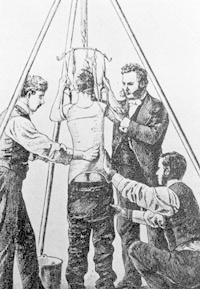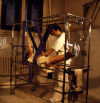Prospective study and new concepts based on scoliosis detorsion of the first 225 early in-brace radiological results with the new Lyon brace: ARTbrace
- PMID: 25741377
- PMCID: PMC4349706
- DOI: 10.1186/1748-7161-9-19
Prospective study and new concepts based on scoliosis detorsion of the first 225 early in-brace radiological results with the new Lyon brace: ARTbrace
Abstract
Background: The symmetrical Lyon brace is a brace, usually used to maintain correction after a plaster cast reduction in the Cotrel's EDF (Elongation-Derotation-Flexion) frame. The new Lyon brace or ARTbrace is an immediate corrective brace based on some of the principles of the plaster cast which are improved due to advances in CAD/CAM technology. The aim of this paper is to describe concepts of this new brace to be not only a replacement of the plaster cast, but also a definitive brace.
Methods: Instead of a plaster cast, three segmental CAD/CAM moulds are made with the instantaneous full 3D raster stereography digitizer (Orten):In self axial elongationIn shift and lumbar lordosisIn shift and thoracic kyphosis A specific software (OrtenShape) makes up the overlay of the three moulds. Mould 1 is used for the pelvis and the shoulders mould 2 for the lumbar segment and mould 3 for the thoracic segment. The mathematical basis of the ARTbrace is the torso column which is a circled helicoid with horizontal circle generator. A torso column is reproduced in the opposite direction of the scoliosis. Like the plaster cast, the ARTbrace is worn for a "total time" of 24 hours 7 days a week without modifying the standard protocol of the Lyon brace reduction. The prospective controlled cohort observational study of the 225 first patients treated since May 2013 is reported below.
Results: The in-brace immediate reduction is: 0.7, i.e. 40% better with the ARTbrace than with a plaster cast. The correction of flat back is 9° (from 18°.4 to 28°.5 kyphosis Cobb angle). The improved aesthetic appearance is equal for rib hump and ATR.
Conclusion: This first paper is an introduction with very short results and does not prejudge the final outcome. The ARTbrace can be used not only to replace the plaster cast, but also as a definitive brace. The new segmental moulding with final detorsion is even more efficient and to this day the ARTbrace is the most effective to reduce the Cobb angle of scoliosis.
Keywords: Brace; Cad/Cam; Concepts; Early results; In-brace correction; Lyon brace; Moulding; Scoliosis; Torsion.
Figures





























Similar articles
-
Lyon brace.Stud Health Technol Inform. 2008;135:327-40. Stud Health Technol Inform. 2008. PMID: 18401102
-
"Brace Technology" Thematic Series - The Lyon approach to the conservative treatment of scoliosis.Scoliosis. 2011 Mar 20;6:4. doi: 10.1186/1748-7161-6-4. Scoliosis. 2011. PMID: 21418597 Free PMC article.
-
Brace technology thematic series - The Sforzesco and Sibilla braces, and the SPoRT (Symmetric, Patient oriented, Rigid, Three-dimensional, active) concept.Scoliosis. 2011 May 9;6:8. doi: 10.1186/1748-7161-6-8. Scoliosis. 2011. PMID: 21554719 Free PMC article.
-
The Lyon brace.Disabil Rehabil Assist Technol. 2008 May;3(3):139-45. doi: 10.1080/17483100801904069. Disabil Rehabil Assist Technol. 2008. PMID: 18465397 Review.
-
Evolution of casting techniques in early-onset and congenital scoliosis.J Clin Orthop Trauma. 2020 Sep-Oct;11(5):810-815. doi: 10.1016/j.jcot.2020.06.034. Epub 2020 Jul 8. J Clin Orthop Trauma. 2020. PMID: 32879567 Free PMC article. Review.
Cited by
-
2016 SOSORT guidelines: orthopaedic and rehabilitation treatment of idiopathic scoliosis during growth.Scoliosis Spinal Disord. 2018 Jan 10;13:3. doi: 10.1186/s13013-017-0145-8. eCollection 2018. Scoliosis Spinal Disord. 2018. PMID: 29435499 Free PMC article. Review.
-
Bracing In The Treatment Of Adolescent Idiopathic Scoliosis: Evidence To Date.Adolesc Health Med Ther. 2019 Oct 8;10:153-172. doi: 10.2147/AHMT.S190565. eCollection 2019. Adolesc Health Med Ther. 2019. PMID: 31632169 Free PMC article.
-
A scoping review of digital fabrication techniques applied to prosthetics & orthotics: Part 2 of 2-orthotics.Prosthet Orthot Int. 2024 Nov 13;49(4):427-444. doi: 10.1097/PXR.0000000000000399. Prosthet Orthot Int. 2024. PMID: 40779362 Free PMC article.
-
SOSORT Award Winner 2015: a multicentre study comparing the SPoRT and ART braces effectiveness according to the SOSORT-SRS recommendations.Scoliosis. 2015 Aug 11;10:23. doi: 10.1186/s13013-015-0049-4. eCollection 2015. Scoliosis. 2015. PMID: 26265932 Free PMC article.
-
Objective Non-irradiant Imaging of Fat Distribution: New Essential Tools for the Bariatric Surgery?Obes Surg. 2016 Aug;26(8):1940-1. doi: 10.1007/s11695-016-2230-0. Obes Surg. 2016. PMID: 27256013 No abstract available.
References
-
- Landauer F, Wimmer C, Behensky H. Estimating the final outcome of brace treatment for idiopathic thoracic scoliosis at 6-month follow-up. Pediatr Rehabil. 2003;6(3–4):201–207. - PubMed
-
- Mammano S, Scapinelli R. Plaster casts for the correction of idiopathic scoliosis. Acta Orthop Belg. 1992;58(Suppl 1):81–84. - PubMed
LinkOut - more resources
Full Text Sources
Other Literature Sources
Miscellaneous

